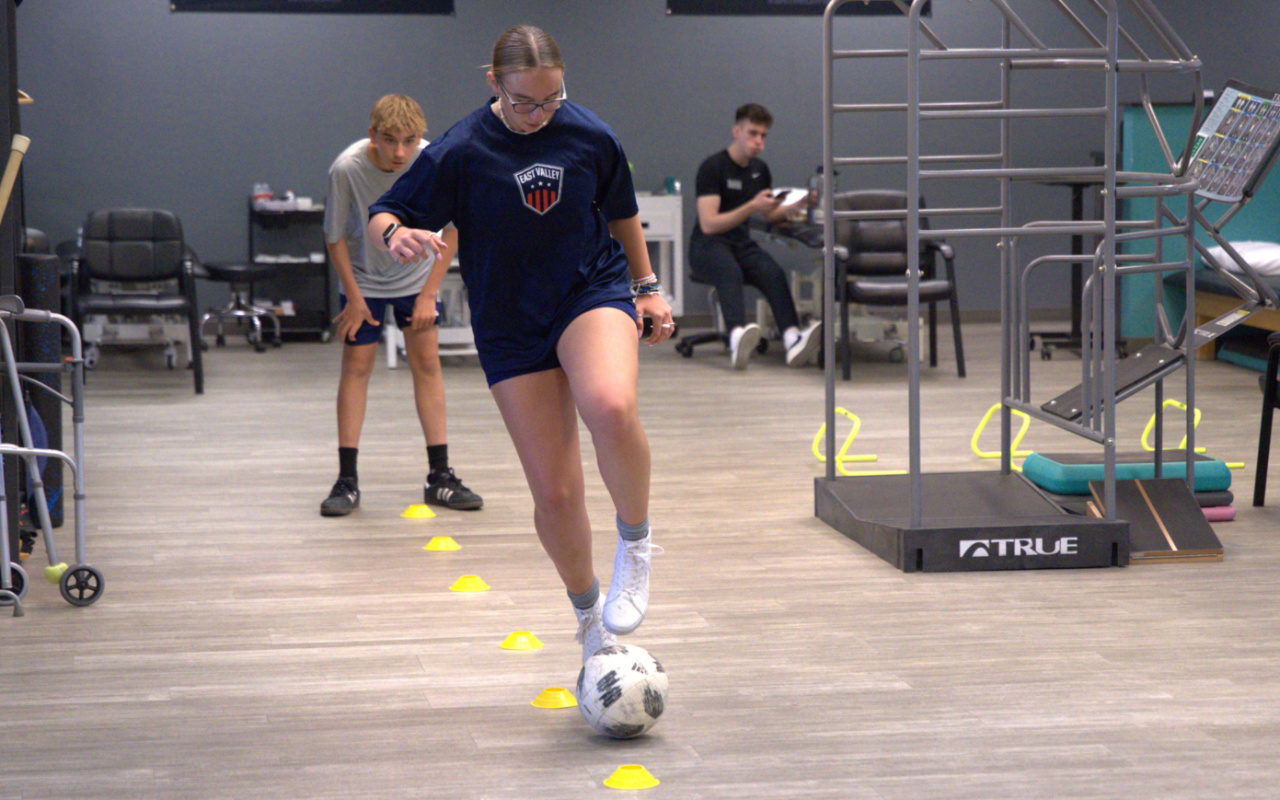The Spring sport season has arrived, and with a surge in activity often comes a surge in injuries. ACL injuries are one of the most common and serious injuries to occur on any sporting field or court. Unfortunately, there’s no way to completely prevent an ACL injury; we wish that were the case! But there are definitely ways athletes can train their bodies to prepare themselves better to handle the stresses that can cause movement breakdown and result in ACL injury. We also have tips for effective training. Read on to learn some best practices from Spooner physical therapist Pete Gorman, PT, DPT, CSCS, including what you can expect if you land in rehab.
“We see ACL injuries in any sport where athletes move at a high rate, and in different directions. Movements such as jumping, landing, quickly changing directions – those can put athlete at an increased risk. This typically occurs in sports like football and soccer, though basketball also presents a high rate of ACL injuries,” said Pete.
First, let’s try to avoid an ACL injury if possible
Impact injuries are a part of participating on a sports team. They’re going to happen. And, actually more often, ACL tears are non-contact in nature, meaning that no contact with another athlete occurred to cause an injury in the first place. Typically, the injuries happen where there’s sudden deceleration and acceleration in more than one plane of movement, like landing from a high jump or quickly slowing down and changing directions.
Okay, wishful thinking aside, athletes should and can train their bodies for success. With proper training, the athlete’s body will handle the demands of their sport better to limit injuries and it will make them a better athlete. At Spooner, we take athletes through movements that may seem “dangerous” so that their bodies learn to decelerate and accelerate in a way that avoids injury and leads to athletic performance. Also, in the event of an ACL tear (or any other injury for that matter), good training will condition them for the long road of rehab and successful return to the sport they love.
There’s no one-size-fits-all playbook. Training properly will look different for each athlete based on their body, their specific needs, and their sport. But Pete does offer a few tips on things to consider:
- Consider a movement screen by a physical therapist. This is to get “fresh eyes” on your body and your movements to look for areas of weakness, restrictions and faulty movement patterns. Most people take physical therapy when they have to – but taking a proactive approach will make you stronger, more balanced and prepared for anything that comes your way. Our therapists watch athletes move all day, so they can easily pick out the areas where you will need to work to better train your body for your sport.
- Don’t feed into bad habits. Pay attention when you train. Your form should be spot-on. Our movement patterns take many repetitions to become a habit. Make sure you are going into your training with a focus on repetition of the best form over and over.
- Simulate the sport. In other words, do what your sport does. Move through the similar patterns as you would on a baseball field or on a basketball court. This may mean that you fold a variety of squats or lunges into your workouts and warm ups.
- Move in all three planes. Move up, down, across and side to side in ways similar to your sporting movements.
“As humans and as athletes, it’s easy for us to slip into autopilot mode. This is why proper form and body awareness is critical to training, because it will help you form better habits,” Pete said.
Rehab for ACL injuries: back to the basics
Coming back after an ACL injury or surgery requires a long commitment and a lot of patience. From acute care post-surgery to regaining basic motions like walking, athletes face a progressive road to full recovery. At Spooner we follow a “Return to Sport” program that starts from week one in the clinic. The program is a seven-stage approach to rehab and performance that safely trains athletes in movement patterns using their entire body (not just the knee!) and eventually trains their body to handle high-level execution of movements that they will need to get back to full performance. For athletes to transition to the next level, they must progress through the requirements of the level prior.
ACL injuries are common. You don’t have to be an athlete to hear about them on the news, or know a friend or family member who has gone through it. But this commonplace aspect often gives off the impression that you have surgery and, bam! you’re right back on the field again.
Nothing could be further from the truth. The whole process can take six to 9 months. And, what you may not learn early is that the process can be just as emotionally draining as it is physically challenging.
“The rehab process is a contract between the therapist and the athlete”, Pete explained. “Achieving good outcomes takes time and hard work and commitment. Athletes will require guidance and support from therapists, but it’s up to them to put in the work.” At Spooner, we work closely with the entire support team of our athletes, from the medical team, to family and coaches. Our goal is to help athletes achieve safe return to sport that avoids injury and leads to great athletic performance!
Learn more about the ACL Injury Rehabilitation Program at Spooner Physical Therapy. Ready to schedule an appointment? Schedule an appointment or complimentary movement screen with a Spooner physical therapist at one of our locations throughout the valley.

